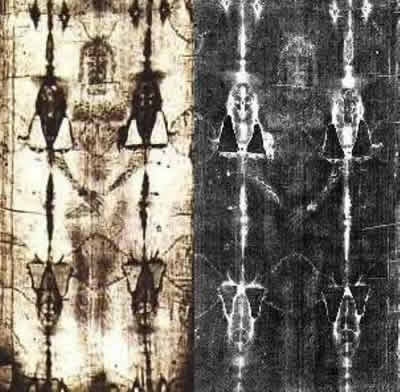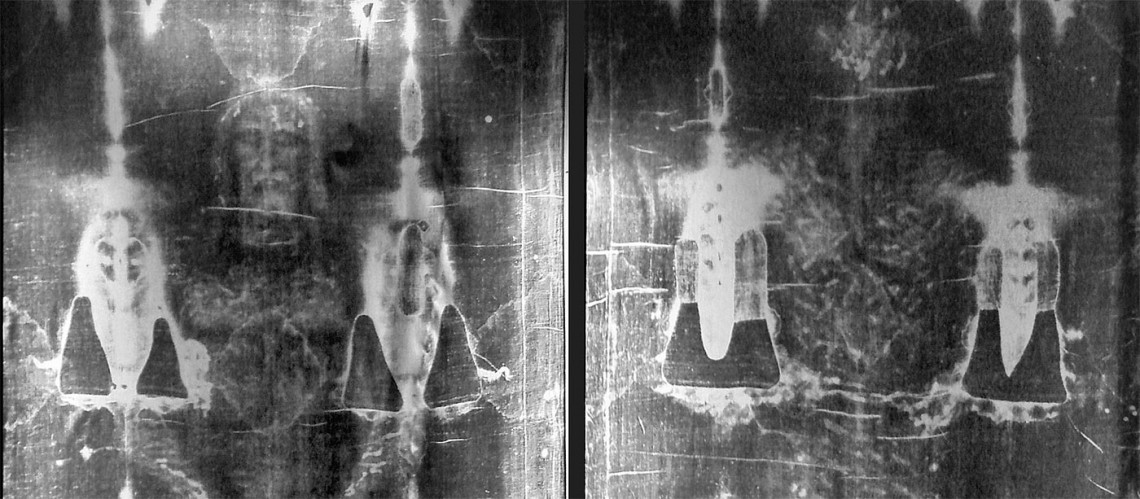03/26/2016 (09:43) – I originally posted this on another blog five years ago on April 18, 2011. Now I’m re-posting it here.
Since this is Easter week, I thought I’d share my recent studies on the Shroud of Turin. If you’re unfamiliar with the shroud, I’ll begin by saying that it is probably the most famous relic in all of Christendom. It is a linen cloth approximately three and a half feet by fourteen feet which contains the blood-marked image of a naked man. This image and the shroud are purported to be of none other than Jesus of Nazareth.
The story of the shroud’s origins most often begins in the 1350’s when a French knight, Geoffery de Charny, brought it to Lirey, France1. Then in 1453 the Charny family gave the shroud to the House of Savoy which owned it into the 20th century2. In 1578, the Savoys brought the shroud to Turin, Italy where it has remained to this day3.

Negative and Positive images of the shroud
For the past couple of centuries the major debate surrounding the shroud has been whether or not it is the work of a 14th century artist. This debate has framed much of my knowledge about the shroud. It has always fascinated me as an ingeniously manufactured fraud; however, I’ve never given much credence to its being the actual burial cloth of Jesus Christ.
My views on the shroud first began to change when I learned of Dr. Gary Habermas’ interest in and study of it. Having read Lee Stobrel’s The Case for Christ and having heard a couple of interviews with Dr. Habermas, I know him to be one of the world’s foremost authorities on the historical evidence for the resurrection of Christ. Given his pedigree, Dr. Habermas’ interest in the shroud caused me to reassess what I knew about it.
Watch the following video to see Dr. Habermas discuss the image on the shroud and its possible cause:
The post I linked to above also links to two other papers by Habermas, one discussing the shroud’s significance to Biblical studies and another responding to some challenges.
The above only served to whet my appetite for further information. So I ended up getting two books: Resurrected: Tangible Evidence that Jesus Rose from the Dead by Gilbert R. Lavoie, M.D. and Verdict on the Shroud: Evidence for the Resurrection of Jesus Christ by Gary R. Habermas and others. So far I’ve only had time to read the first of the two books, but given how fascinating it was, I’m looking forward to reading the other.
In Resurrected, physician Gilbert R. Lavoie shares the story of his fascination with the shroud and recounts the evidence he discovered which point to the shroud’s authenticity. These evidences include pollen grains on the shroud which are consistent with plants found around Jerusalem, further historical accounts which place the shroud’s origin in the 1st century, information on Jewish burial customs which corroborate why the man in shroud was not washed before burial as is required with standard Jewish burials, and a microscopic examination of the extraordinary nature of the image on the shroud. I finished the book with a much greater appreciation of and fascination with the shroud.
Having shared all of this with you, my goal is to perhaps inspire you to continue with the same study. Whether you are a Christ-follower or not, The Shroud of Turin holds no small amount of intrigue and mystery. On the one hand, the Christian is left to wonder and marvel at the significance of God’s having possibly left behind a physical evidence of Christ’s resurrection. On the other hand, the non-religious person is presented with an enigmatic relic whose manufacture continues to confound modern science.


Leave a Reply